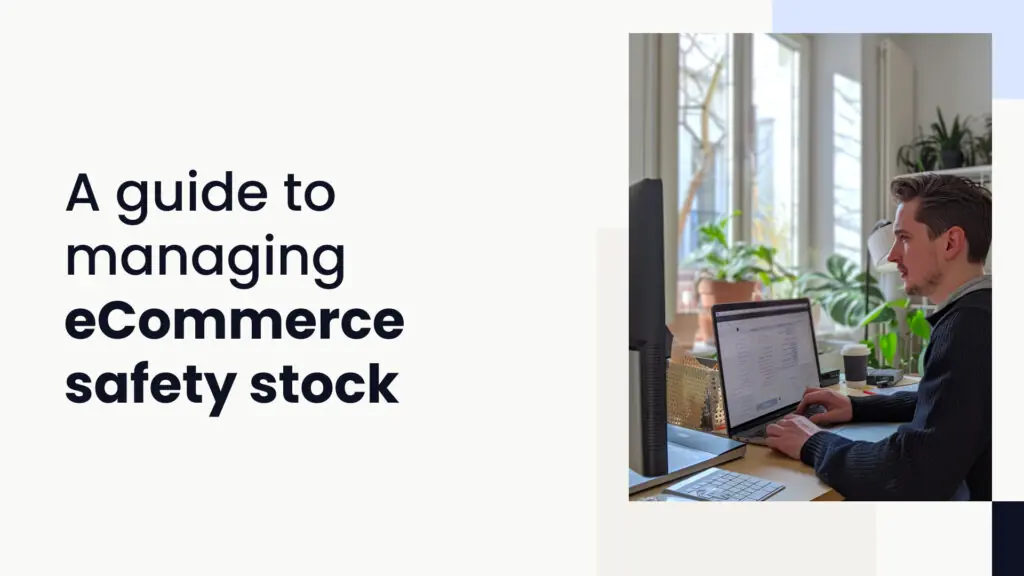Staying in stock is the bread and butter of every eCommerce business. Nothing can derail an online store’s operations like a poorly timed stockout. It is for this reason that many sellers decide to set up safety stock, which means keeping a batch of inventory at a nearby warehouse for when you truly need it. This might happen if a shipment is delayed or sales soar unexpectedly. Safety stock bears an additional cost but can prove to be a great investment in the long run. At the right moment, it may save your business huge sums by preventing a stockout and keeping sales flowing.
Fund your inventory with 8fig!
What is safety stock?
The main purpose of safety stock is to act as a buffer against disruptions to your supply chain. By setting aside a batch of goods you protect yourself in case of problems emerging in the future. An eCommerce business usually sets up safety stock in a local warehouse, near their distribution center. This way it can be accessed relatively quickly to respond to shortages elsewhere.
Why is safety stock important?
Safety stock acts as an insurance against the disruptions and delays that are common in eCommerce. Even though running out of stock may seem unlikely in the present, you don’t know what could await. Errors in demand forecasting or issues in your supplier’s operations are more common than you might think. The past few years showed that global events like COVID-19, the Russian invasion of Ukraine, and climate disasters, can bring even the most well-oiled supply chains to a halt.
Even if everything seems fine at the moment, safety stock provides peace of mind as it ensures that you are ready for the worst. Here are some of the biggest benefits fo safety stock:
Readiness for demand spikes
Nothing is worse than running out of inventory right as your sales are peaking and your online store is getting ranked higher and higher. Safety stock is intended for moments like these, to keep your momentum going. No matter how well you plan in advance, consumer behavior can be extremely volatile. A single TikTok video can go viral, causing demand to skyrocket out of the blue.
Pro tip
No only will safety stock maximize your revenue, it also ensures you don’t lose business to competitors, which would boost their rankings.
Cushioning against disruptions
As most seasoned eCommerce sellers know, a million things can go wrong during the inventory shipping process. Everything from a labeling error to new customs laws can result in you not getting your products when you need them. Oftentimes, it can take days before you even know your goods’ journey came to a halt. With safety stock, you take away the potential pain a supply chain disruption could cause.
We’ll ask a few quick questions to better understand your specific business needs. Then, we’ll build a funding plan tailored to your expenses.
Subscribe to the eCommerce newsletter for
top industry insights
Customer satisfaction
Few things can frustrate customers like their order not arriving when expected. Some sellers can be tempted to keep selling when stock runs low, even if they’re still waiting for product shipments to come in. This is called “backordering” and it can be risky. Excessive delays or failed fulfillment can anger customers, leading to negative reviews and tedious refund processing. With safety stock, you can quickly meet customer demand and keep your sales flowing.
Lower shipping costs
When faced with a looming stockout, some sellers order more inventory with fast shipping or from a local, more expensive supplier. This is a good response when you have spent a lot on marketing campaigns, seeking a better ranking and more reviews and want to keep that momentum going. However, that means paying a premium for shipping. Safety stock that is transported at the standard rate will keep your profit margins in a healthy state.
Wait, why is stocking out so bad?
It might seem that the cost of putting aside safety stock is too high for you. However, you should be aware of the downsides of not having stock on hand when it is needed. Let’s say a shipment is late and you can’t replace your inventory in time so you run out of stock and halt sales.
Marketplaces like Amazon will immediately rank your products lower, benefiting your competitors. This makes sense to them because buyers seeing products that aren’t available to purchase right away will result in a worse customer experience. In such a scenario, all the marketing dollars you spent to increase your reach will be wasted.
Further issues emerge with the customers themselves. Many people love to buy from the same brands they know and trust again and again, for example, with subscription services. This is the dream customer for any store. A poorly-timed stockout might drive them to buy from a competitor and stick with them long-term. Finally, customers pay close attention to the timing of reviews. A lack of recent positive reviews might lead to worries about a reduction in product quality. There are countless ways stockouts undermine your store’s performance.
Might also interest you:
How do you calculate safety stock?
Once you do decide you want to invest in safety stock, one of the hardest questions is how large this stash should be. Too much safety stock can lead to large warehousing costs, while too little will defeat its purpose. Thankfully, there are a few formulas that you can use to calculate the ideal balance for your business. Here are some approaches:
This first approach is the easiest and most straightforward. In essence, you find out your average daily sales and then calculate how much stock you will need to be safe over a given number of days.
If, for example, you sell an average of 100 of a given product per day, and you want to give yourself a safety period of 20 days, you put the required amount of inventory aside. That would mean stocking 2000 of the products in question.
This formula calculates the average stock that will help you through a stockout situation. However, it doesn’t consider fluctuations during the year, such as holidays, events, and seasons.
Safety Stock =
(max. daily usage x max. lead times) – (average daily usage x average lead time in days)
You multiply the maximum daily usage (units sold per day) with the maximum lead time (the period it takes the supplier to deliver the stock). Then, you subtract the average daily usage multiplied by the average lead time. It could look something like this:
300 x 30 – 200 x 20
In this example, the product sees an average of 200 sales per day, with a maximum of 300 daily sales. The average lead time is 20 days, which can reach a maximum of 30 days. The result is 5000, which is the number of products that should be kept in your safety stock to prevent a stockout.
Common stockout risks
Stockouts can happen to every kind of eCommerce business. No one is safe from unexpected circumstances or human error. Even if it seems unlikely right now, a poorly timed disruption can interrupt your supply chain and put a complete halt to your sales. Here are some scenarios that could lead to such a situation:
1. Inaccurate demand planning
Every eCommerce seller should be doing some sort of demand forecasting. Whether you do it on your own or use a service to help you, this is the first step to avoiding stockouts. Analyzing and working to predict your future sales is a habit that will grow your understanding of this data. The more you work with it, the more patterns and trends you will recognize, giving you a sense of what to expect and look for.
Inaccurate demand forecasting means your store might experience up- or downticks in sales that don’t correspond with your inventory levels. This is likely to leave you with bloated storage costs or missed sales momentum.
2. Unexpected surges
Big surges in demand are simultaneously a dream and a potential nightmare for eCommerce sellers. Increased sales are clearly a good thing, but not being able to meet this rising demand can become a major lost opportunity. If you sell out at a time when demand is peaking you will lose out on the bulk of sales to your competitors.
Popular content
View articles
Maybe you haven’t yet experienced a rapid surge in interest from buyers, but this is somewhat common in the world of online selling. A new TikTok trend could triple demand for your products overnight. Safety stock is one of the best ways to protect yourself from wasted store growth in this situation.
3. Inventory management errors
Even if your supply chain is currently a well-oiled machine, you should always take precautions to protect yourself from stocking out. Small human mistakes in the management process can lead to major disruptions to your operations. Errors in order processing, data entry, communication, or forecasting can bring sales to a complete stop.
Performing regular inventory audits is a good way to prevent many of these issues from emerging. An inventory management service is also a good solution. With safety stock, you know that you will have extra breathing room if all else fails.
4. Timing
Given the variance in certain lead times, it can be difficult to estimate the right time to order inventory. You want to prevent stockouts but also avoid excessive storage fees for unsold goods. Additionally, suppliers can have their own issues, such as being overwhelmed by a backlog of orders or lacking manufacturing materials. Even a correctly timed order can arrive well after it is needed.
5. Natural disasters
Sadly, the frequency of natural disasters in the US is increasing. Power outages due to weather, hurricanes, or floods can decimate supply chains. While we can’t predict these setbacks, we can prepare for them. Safety stock and diversifying where you store your inventory are great ways to protect yourself. Having warehouses that ship your products in several locations might increase your transport costs but will protect you against the unforeseeable.
Downsides of keeping safety stock
Before you make the substantial investment to keep safety stock, you need to be aware that it may not be right for every business. Stores that don’t experience big surges in demand or have long lead times (the period between making and receiving inventory orders) might want to do things differently. Here are some additional factors to consider:
Increased holding expenses
The first and foremost downside of safety stock is that you will lose a bigger portion of your cash flow to storage. One of the benefits of selling off stock as soon as it comes in is that your storage costs go down. Holding on to wares for a long period will drain funds consistently. This expense can be watered down by choosing a storage partner that is less costly due to the long-term commitment and lower necessity of regular small shipments. However, you need to make sure your business can stomach this added expense.
Tied-up funds
ECommerce sellers tend to operate under extremely thin margins. Normally, they reinvest all, or at least the vast majority, of their profits back into the business. This is usually in the form of increased marketing, new products, or improved shipping conditions. If you aren’t particularly prone to stockouts and don’t see clear benefits in safety stock, it might be better for your store’s growth trajectory to invest elsewhere.
Risk of obsolescence
The world of online selling is particularly fast-paced and trend-oriented. Fidget spinners sold like hotcakes when they burst onto the scene in 2017. The market quickly became oversaturated and highly competitive, resulting in significantly reduced profit margins for most sellers.
If you hold on to stock for too long, there is a risk that demand falls, leaving you with unsold wares that keep costing you storage fees. For example, if you sell a fashion item like leather slings, which are in vogue right now, shifting trends can quickly reduce demand.
Lack of flexibility
If you have a large trove of safety stock, you will have more difficulty adapting to shifting market trends. You are betting on your prediction of demand being correct. If previously you would have invested in and started selling a new trending product right away, you will have to wait now. Unless you have big cash reserves, holding safety stock means you will have to sell your old inventory before any big new investments can be made.
Conclusion
Putting aside some safety stock can be a massive asset to any eCommerce business. Even just the peace of mind that comes with knowing you are ready for the worst is a major advantage. Preventing stockouts, especially when sales are reaching their peak, will help keep your sales growth consistent. Before you decide to acquire safety stock, however, you should make sure you have a good understanding of the amounts that suit your business.
You also need to be sure that you are stocking up on products that aren’t prone to losing value due to shifting trends. When planned correctly, safety stock can help a business keep performing at its best and avoid critical disruptions.
If you don’t have the capital on hand to invest in safety stock, you may want to check out an 8fig Growth Plan. It will give you the funding you need, which you can invest in your business however you please. No collateral is required, and there are no hidden fees. Instead, you agree upon a cost of capital with a remittance schedule that is tailored to correspond with your sales. 8fig’s funding is fast and flexible, you can get approved within a day and your remittance schedule is adjustable. Sign up with 8fig today and take your business to the next level.
Have article ideas, requests, or collaboration proposals? Reach out to us at editor@8fig.co – we’d love to hear from you.




